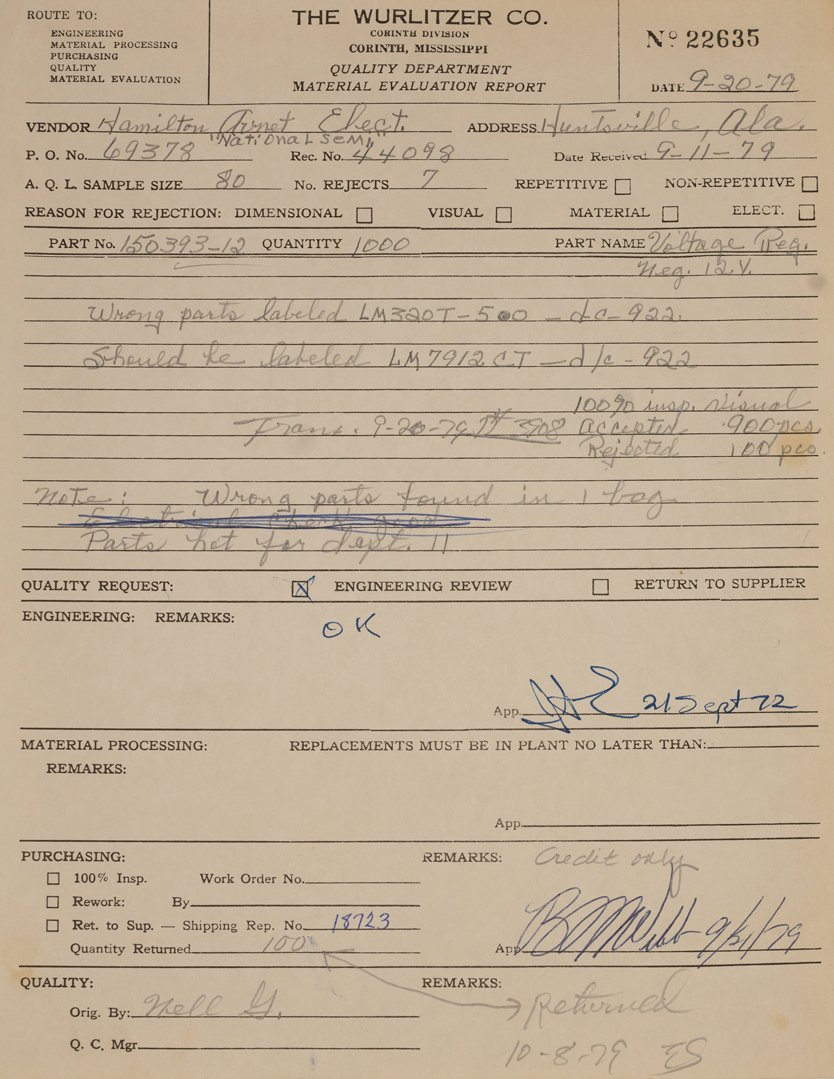Help us preserve an archive of Wurlitzer Co. engineering drawings and documents
In November 2022, Tropical Fish acquired the contents of thirteen filing cabinets from a warehouse previously owned by a former Wurlitzer employee. These cabinets contained tens of thousands of blueprints, engineering drawings and related documents, each one dating from the 1960s to the 1980s.
These drawings depict an electronic or mechanical part from a Wurlitzer organ, electronic piano, or amplifier. They include the part’s dimensions, materials, vendor, and other information.
Many of the drawings are accompanied by a Parts History Record, which lists how many units of that part were purchased by the Wurlitzer Co., and on what date. Some also contain Quality Control forms, which report on flaws discovered during inspection of the shipment.
PART NO. 11-0268: 140/145 ELECTRONIC PIANO GLIDE
These drawings are extremely useful for the restoration of vintage Wurlitzer keyboards, and possibly other amplified instruments from the same time period. The drawings contain a far greater level of detail than service manuals. For many parts, this detail goes beyond basic dimensions and specifications. The Quality Control forms provide a window into the process and the challenges of manufacturing parts for analog instruments. This is useful information for restorationists, because it shows why certain design decisions were made, and illuminates some of the priorities of Wurlitzer’s engineers.
PART NO. 150393: VOLTAGE REGULATOR FOR WURLITZER ORGANS
Wurlitzer made use of the latest advances in consumer technology to manufacture their organs and other electronic instruments. Up until the 1980s, the information in these documents was considered highly sensitive, and access to it was closely held within the company. When the factory closed, the Wurlitzer engineer who acquired these documents kept them in his personal filing cabinets for nearly 40 years.
In the meantime, musicians and technicians who have sought to repair vintage Wurlitzer keyboards have been frustrated by the lack of information on the obsolete electronics and other parts within these instruments. Certain components have been widely believed to be unfixable or irreplaceable. Access to the specs in these documents will make it possible to source equivalent components, keeping Wurlitzer keyboards working now and in the future.
part no. 11-0301, 11-0302, 11-0305, and 11-0306: pedal base assembly for wurlitzer 140 electronic pianos
This collection of documents contains essential practical and historical information about electronic pianos and organs of the 1960s, the 1970s, and the 1980s. Considering that the Wurlitzer Co. has been defunct for nearly 40 years now, the time for gatekeeping is long past.
We would like to make the information in these documents available to everyone who is interested. This is the best way to keep Wurlitzer instruments fully-functional, out of landfills, and in the hands of musicians.
part no. 509077: name plate for model 435, 465, 545 and 555 organs
Next steps
We currently have the documents in over 100 bankers’ boxes. Each box contains between 75 and 200 engineering drawings. About half of the boxes contain unfiled engineering drawings, without any supporting documentation. In the other half, engineering drawings are filed in hanging file folders, which also contain the corresponding Parts History Record, Quality Reports, and other paperwork.
We would like to, first of all, digitize the files. Then, we would like to archive them appropriately, so that they can be stored for the long term with minimal environmental damage.
digitizing the files
Digitizing the files is important to us. As far as we know, we possess the only copies of these documents, so we would like to create a digital backup of the collection. Converting them to a digital format would also make it easier to share the documents with anyone who is interested in reading them.
The drawings range in size from 8.5x11” to 36x48”. Using the equipment we currently have, we are able to make high-quality, high-resolution scans of 8.5x11” drawings. These scans are sharp and true to the original colors of the drawings, with no chromatic aberration and minimal lens distortion. The images shown above are examples of our scans, at web resolution.
With a small amount of additional equipment, we could also scan larger documents, likely up to 17x24”. We plan to explore options for scanning the largest documents in the collection.
To facilitate efficient scanning, we are currently sorting the documents by paper size.
archiving the files
All documents above 8.5x11” were folded, in order to fit into the filing cabinets where they spent the last 40 years. The documents that were stored in hanging folders are, overall, in good condition. However, many of the unfiled documents are bent or creased, due to the way they were stored in the filing cabinets. For short-term storage, we are filing them in letter-sized folders, which will protect them from further damage.
In the future, we hope to transfer the collection into archival-quality containers that are more appropriate for long-term preservation.
You can help by donating
The best way to support this initiative is by donating to our gofundme. From the very start of saving these documents, we knew it would take more than just us to get the job done. It is a big task, and even the cost of basic organizational supplies for these documents, such as file folders and bankers boxes adds up. We appreciate every contribution and the support we get to preserve this one of a kind collection of documents.






















